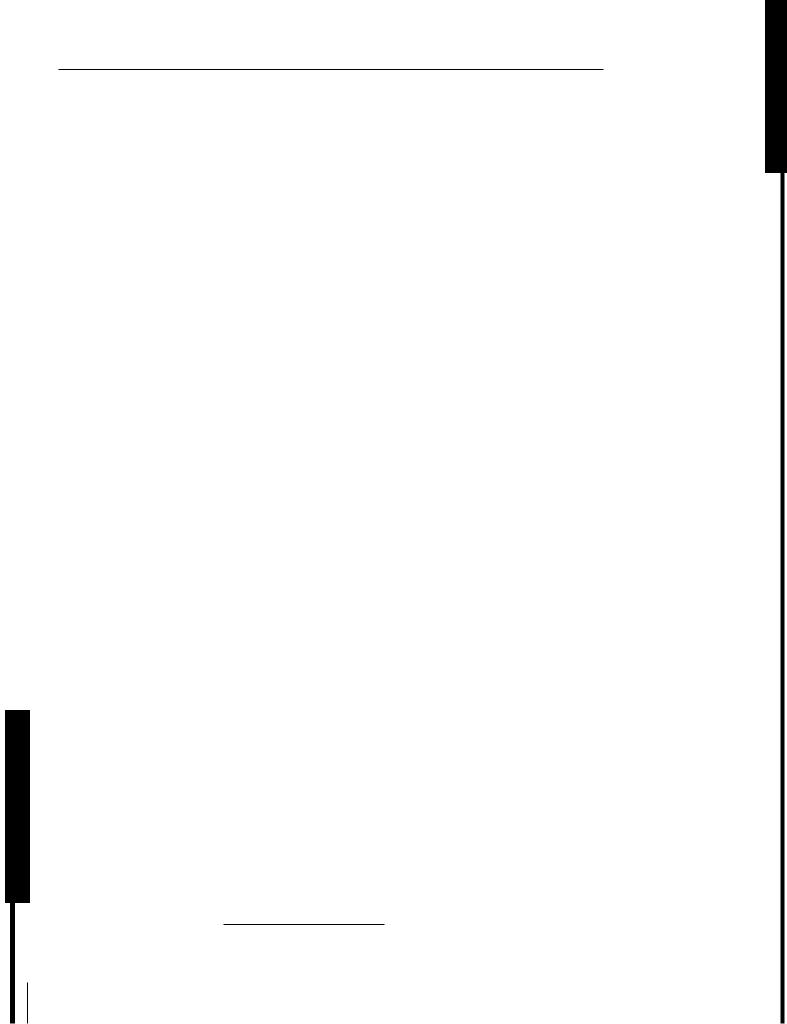
Writing_Academic_English
.pdf
II.,
,'.
32 Pal"t 1 I Writing a Paragraph |
_ |
PRACTICE 8
'-'Using Transition
Signals
advantage is that a BO can record, store, and play back high-definition video because of its larger capacity. A double-layer BO can store about 50 gigabytes, enough for 4.5 hours of high-definition video. The cost will be about the same.
(5) (additional idea), a BO has a higher date transfer rate-
36 megabits per second-than today'sOVOs, which transfer at 10 megabits per
second. (6) |
(result) a BO can record 25 gigabytes of data in |
just over an hour and a half. (7) |
(conclusion) because of |
their large storage capacity and comparable cost, BOs will probably take over the market when they become widely available.
Choose one of the two topic sentences that follow and write a paragraph that develops it. Use transition signals to connect the supporting sentences smoothly. You may use the transition signals suggested for each topic, or you may use others not listed. Add other sentences without transitions if you need to in order to explain the topic completely.
Sentence 1. There are four noticeable differences between British and American English.
the most noticeable difference |
such as |
for example |
finally |
another difference |
for instance |
for example |
in conclusion |
a third difference |
|
Here are some possible subtopics for your paragraph. You may, of course, use your own if you wish.
Subtopics |
Examples |
Pronunciation |
Speakers of British English do not always pronounce r. |
|
schedule: In British English it is pronounced |
|
[shed-u-al]; in American English it is |
|
pronounced [sked-u-al] |
Spelling |
colour/color; realise/realize; defence/defense |
Vocabulary |
petrol/gas; biscuit/cookie; pocket money/allowance; |
|
bonnet/hood |
Sentence 2. Sometimes I enjoy being alone.
for instance |
on the other hand |
moreover |
therefore |
Don't Overuse Transition Signals
Read your paragraph aloud and pay attention to your own language. Are you using too many transition signals? Too many can be distracting rather than helpful. There is no rule about how many to use in one paragraph. Use them only when they will help your reader follow your ideas.

PRACTICE 9
Too Many
Transition
5ignals
Chapter 2 I Unit1l and Coherence 33
The following paragraph has too many transition signals. Which ones are helpful to the reader? Which transition signals are an unnecessary distraction?
Step 1 Improve the paragraph by deleting some transition signals. You may want to rewrite sentences, and you may have to change the capitalization and punctuation.
Step 2 There are many possible ways to do this assignment. Discuss your changes with a partner or in a group.
How to Grow an Avocado Treel
After you have enjoyed the delicious taste of an avocado, do not throw out the seed! You can grow a beautiful houseplant or even your own tree by following these simple steps. First, wash the seed. Second, dry it. Third, insert three toothpicks into its thickest part. Then fill a glass or empty jar with water. After that, suspend the seed in the water with the pointed end up and the broad end down. The water should cover about an inch of the seed. Next, putjhe glass in a warm place, but not in direct sunlight. Add water when necessary to keep the bottom of the seed under water at all times. In two to six weeks, you should see roots begin to grow. Furthermore, the seed will crack open, and then a stem will emerge from the top. However, wait until the stem is 6 to 7 inches long. Then cut it back to about 3 inches. Now wait until the roots are thick and the stem has leafed out again. Then fill an 8- to 10-inch diameter clay pot with enriched potting soil. Plant the seed, leaving the top half exposed. Then water it well. After that, water frequently but lightly; also give the plant an occasional deep soaking. However, do not overwater your little tree. Yellow leaves are a sign of too much water. Then place the potted plant in a sunny window and watch it grow. The more sunlight, the better; Then, when the stem is 12 inches high, cut it back to 6 inches to encourage the growth of side branches. In just a few more weeks, you will have a beautiful indoor plant. In conclusion, enjoy your new plant, but do not expect it to bear fruit. Avocados grown from seed occasionally flower and bear fruit; however, first you will have to plant it outside and then wait anywhere from five to thirteen years.
I"Grow Your Own Tree." California Avocado Commission. 6 Dec. 2004 <http://www.avocado.org/ avocado-facts/growing-avocado. php>.

34 Part 1 I Writing a Paragraph
"Logica.l Order In addition to using transition signals and repeating key nouns and pronouns, a fourth way to achieve coherence is to arrange your sentences in some kind of logical order.
Your choice of one kind of logical order over another will, of course, depend on your topic and your purpose. You may even combine two or more different logical orders in the same paragraph. The important point to remember is to arrange your ideas in some kind of order that is logical to a reader accustomed to the English way of writing.
Some common kinds of logical order in English are chronological order, logical division of ideas, and comparison/contrast.
•Chronological order is order by time-a sequence of events or steps in
a process. The model paragraph on how to grow an avocado tree (page 33) uses time order to organize the steps.
•In logical division of ideas, a topic is divided into parts, and each part is discussed separately. The model paragraph about gold on page 3 uses logical division. First, it discusses gold's beauty, and second its utility.
•In a comparison/contrast paragraph, the similarities and/or differences between two or more items are discussed. The paragraph about synonyms on page 5 compares and contrasts word meanings.
RRA.CT1CE 10 |
Read the following paragraphs and decide which kind of logical order is used in |
----each: comparison/contrast, chronological order, or logical division of ideas. Be able
Recognizing
to discuss the reasons for your choice. Circle all transition signals.
Kinds of "Logical
Order
Paragraph 1
The process of machine translation of languages is complex. To translate
a document from English into Japanese, for example, the computer first analyzes an English sentence, determining its grammatical structure and identifying the subject, verb, objects, and modifiers. Next, the words are translated by an English-Japanese dictionary. After that, another part of the computer program analyzes the resulting awkward jumble'of words and meanings and produces
an intelligible sentence based on the rules of Japanese syntax2 and the machine'sunderstanding of what the original English sentence meant. Finally, a human bilingual editor polishes the computer-produced translation.
Kind of logical order: _
Ijumble: confused mixture
2syntax: sentence structure, grammar

Cbapter 2 I Unit1j and Coherence 35
Paragraph 2
French and U.S. business managers have decidedly different management styles. French meetings, for example, are long and rambling3 and rarely end on time. Furthermore, meetings often end without closure.4 Managers in the United States, on the other hand, make an effort to start and stop a meeting on time, and North American business meetings typically end with decisions and action plans. Another difference involves documentation. North Americans adore documentation; they have a procedure manual for everything. The French, in contrast, think this is childish. French managers find it difficult to stick to a schedule, but U.S. managers are intolerant of delays. In addition, the French prefer to work alone, whereas North Americans like to work in teams. Another major difference in management style is that in French companies, authority comes from the top; French managers do not share information with subordinates and make decisions with little participation by employees beneath them. In U.S. companies, however, top managers share information and frequently solicit5 input from subordinates ("How French Managers'V
Kind of logical order: ~__'__ _
Paragraph 3
It took more than 2,500 years to develop the calendar used in most Western countries today. In about 700 B.C.E.,7 the ancient Romans used a calendar that had 304 days divided into 10 months; March was the beginning of each year. There were more than 60 days missing from the calendar, so very soon the calendar did not match the seasons at all. Spring arrived when the calendar said that it was still winter. A few decades later, the Romans added the months of January and February to the end of the year. This calendar lasted about
600 years. Then in 46 B.C.E., Julius Caesar, the Roman ruler, made a new calendar. His calendar had 365 days, with one day added every fourth year. He also moved the beginning of the year to January 1, and he renamed a month for himself: Julius (July). In Caesar'scalendar, February had 29 days. The very next emperor, Augustus, not only renamed a month for himself (August), but he also took one day from February and added it to August so that "his" month would be just as long as Caesar's.This calendar worked better than the previous ones, but it still was not perfect. By 1580, the first calendrical day of spring was
10 days too early, so in 1582, Pope Gregory XIII, the leader of the Roman Catholic religion, made a small change to make the calendar more accurate. In the Gregorian calendar, the year is still 26.3 seconds different from the solar year, but it will be a long time before this causes a problem.
Kjnd of logical order: _
3rambling: not focused on a specific goal 4closure: decisions about points discussed 5solicit: ask for
6"How French Managers Compare to Americans." Money Beat. Marin Independent Joumal30 Nov. 1993: B7. 7B.C.E.: Before the Common Era (The Common Era began in the year 1.)

36 Part 1 I Writing a Paragraph
...............------------------------------------
.:.
Paragraph 4
The many different calendars used throughout the world are all based on the phases of the moon, on the revolution of Earth around the sun, or on a combination of the two. The first kind of calendar is the lunar calendar, based on the phases of the moon. A month is calculated as the time between two full
moons, 29.5 days, and a year has 354 days. The Islamic calendar used in Muslim countries is a lunar calendar. It has 12 months and a cycle of 30 years in which the 2nd, 5th, 7th, 10th, 13th, 16th, 18th, 21 st, 24th, 26th, and 29th years have 355 days, and the others 354 days. A second kind of calendar is the solar calendar, which is based on the revolution of Earth around the sun. The ancient Egyptians used a solar calendar divided into 12 months of 30 days each, which left 5 uncounted days at the end of each year. A very accurate calendar developed by the Mayan Indians in North America was also a solar calendar.
It had 365 days, 364 of which were divided into 28 weeks of 13 days each. The new year began on the 365th day. Because the solar year is exactly 365 days, 5 hours, 48 minutes, and 46 seconds long, however, a solar calendar is not totally accurate, so many cultures developed a third kind of calendar, the lunisolar calendar. In a lunisolar calendar, extra days are added every so often to reconcile! the lunar months with the solar year. The Chinese, Hebrew, and Gregorian calendars used today are lunisolar calendars.
Kind of logical order: |
_ |
Review
These are the important points covered in this chapter.
1.Every good paragraph has both unity and coherence.
2.You achieve unity by
•discussing only one idea in a paragraph.
•always staying on the topic in your supporting sentences.
3.You achieve coherence by
•repeating key nouns.
•using consistent pronouns.
•using transition signals.
•arranging your ideas in some kind of logical order.
4.There are different types of transition signals. Each type is punctuated differently.
Ireconcile: bring into agreement

|
|
|
Chapter 2 I Unit!! and Coherence 37 |
|
|
In the following paragraph, notice how the four elements work together to create |
|||
|
a unified and coherent paragraph. |
|
||
|
|
A Leap Year Custom Lives On |
||
ALL SENTENCES ARE |
propose marriage on Leap Day. Leap D |
29th, the extra day |
||
RELATED TO THE TOPIC. |
||||
|
|
|
||
|
added every four years to put th |
nch with the solar year. |
||
KEY NOUNS ARE REPEATED, |
|
|
ccording to Irish legend, |
|
AND SYNONYMS ARE USED. |
|
|
century, complained to |
|
|
|
|
||
PRONOUNS ARE |
|
|
|
|
CONSISTENT. |
|
|
ed th t eager females could pro- |
|
|
|
|
||
TRANSITION SIGNALS HELP |
|
|
the custom comes from medieval |
|
THE READER FOLLOW THE:====';:'=-:::1-=:::-::r-h::-=-=:=r;::c:::-:;=-:;:;::-;:'" |
p there thought that because eap |
|||
PROGRESSION OF IDEAS. |
Eng and. Accor ing to this xplanation, pe |
|||
|
Day existed to fix a pro em in the calend |
r, It could also be used to fix-em |
||
|
old and unjust practice. In 1288, the custo |
became an actual law in Scotland. |
||
|
Not only did the Scottish law allow wome |
to propose on any day during a Leap . |
||
IDEAS ARE PRESENTED IN |
Year, but~y man who d dined a woman proposal had to |
|||
|
|
|
||
LOGICAL ORDER. |
|
|
|
|
|
pay a fine! Whatever its origins, the tradition of women taking the initiative |
|||
|
one day a year lives on in Sadie Hawkins Day celebrations held in many |
|||
|
communities in the United States even today. |
|||
RRACT1CE n |
Step 1 |
Turn back to Practice IB on page 7, in which you selected the topic |
||
Review |
|
sentence in each group and marked it TS. |
||
Step 2 |
Now put the supporting sentences of Paragraphs 2, 3, and 4 in order |
|||
|
||||
of Coherence
and mark them SSl, SS2, SS3, and so on.
• Skip Paragraph 1, for it lacks transition w9rds or other clues.
• Use your knowledge of coherence-especially transition signals and repetition of key nouns-to determine the correct order.
Writing Practice
Unity and
Coherence
Step 1 |
Choose one of the topics suggested and write a paragraph that is 10 |
|
to 15 sentences in length. Focus on giving your paragraph unity and |
|
coherence. Follow the steps in the writing process. (See Appendix A.) |
Step 2 |
After you have completed your first draft, use Self-Editing Worksheet |
|
2 on page 319. Revise your paragraph and write a second draft if |
|
necessary. |
Step 3 |
Exchange papers with a classmate and check each other's paragraph |
|
using Peer-Editing Worksheet 2 on page 320. After your classmate has |
|
completed the checklist, discuss it and decide what changes you |
|
should make. |

38 Part 1 I Writing a Paragraph
Step 4 Revise your paragraph and write a final copy to hand in, making any improvements you discussed with your peer editor.
Step 5 Hand in your first draft, your second draft, your final copy, and the page containing the two editing worksheets. Your instructor may also ask you to hand in any prewriting (brainstorming and/or outline) that you did for this assignment.
PRACTICE 13
Writing under
Pressure
Topic Suggestions
The influence of birth order on personality
One (or two) place(s) a visitor to your country should not miss The disadvantages of being left-handed
A fad, fashion, or activity of your generation that drives an older generation crazy
An interesting custom or special celebration from your culture
Choose one of the topics listed below and write a well-organized paragraph. Your instructor will give you a time limit. Try to use a specific example to support your topic sentence.
•Spend I or 2 minutes at the beginning thinking of ideas and organizing them.
•Spend 1 minute at the end checking your work for errors.
•Spend the remaining time writing.
Topic Suggestions
Why you do a certain sport
Why you don't like to do sports
Why you are a morning person (or a night person)
Your opinion about genetic engineering

Supporting Details: Facts,
Ouotations, and Statistics
Academic writing normally requires that you support your ideas and opinions with facts, statistics, quotations, and similar kinds of information. You get these kinds of supporting details from outside sources such as books, magazines, newspapers, Web sites, personal interviews, and so on.
 Opinions
Opinions
First, it is important to distinguish between facts and opinions. Opinions are subjective statements based on a person's beliefs or attitudes.
Men are better drivers than women.
Smoking is a bad habit.
English is an easy language to learn.
39

40. Part 1 I Writing a Paragraph
Opinions are not acceptable as support. It is certainly acceptable to express opinions in academic writing. In fact, most professors want you to express your own ideas. However, you may not use an opinion as support, and if you express an opinion, you must support it with facts. Facts are objective statements of truths.
At sea level, water boils at 100 degrees Celsius.
Women live longer than men.
Cigarettes are addictive.
Sometimes even facts need proof. While all three statements above are facts, the last two need proof. Your readers may not believe that women live longer than men, or they may not agree that cigarettes are addictive. You have to use specific suppOliing details to prove that these statements are true facts. Kinds of specific supporting details include examples, statistics, and quotations.
OPINION
Photographs of ultrathin fashion models send the wrong message to girls and young women.
FACT, BUT NEEDS PROOF
SPECIFIC SUPPORTING DETAIL
PRACTICE I
Specific
Supporting
Details
Fashion models are unnaturally thin.
The average model weighs 25 percent less than the average woman of the same height.
Step 1 Decide which of the following statements is an opinion, a fact that needs proof, or a specific supporting detail. Write
•0 for opinion
•F-NP for fact that needs proof
•SSD for specific supporting detail
Step 2 Discuss with your classmates what specific supporting details you might use to support the sentences you marked 0 and F-NP.
The first three have been done for you as examples.
F-NP 1. People who steal identities do a lot of damage before
their victims become aware of it. (The writer could give an example of a person who was victilnized before noticing it.)
o 2. Punishment for identity thieves is not severe enough.
(The writer could give an example of a typical punishment.)
55D 3. Last year, the losses of victims totaled more than $7 billion.
____ 4. Identity theft is more serious than any other type of theft.
____ 5. Identity theft is increasing at a rapid pace.
____ 6. In 2000, 31,000 cases of identity theft were reported to the Federal Trade Commission (FTC); in 2003, the number was 210,000.
____ 7. Most people do not report identity theft to the police.
____ 8. In 2003, 60 percent of identity theft victims did not notify the police, according to the FTC.
____ 9. Identity theft happens to ordinary people, not just to the wealthy.

Chapter 3 I Supporting Details: Facts, Quotations, and Statistics 41
____ 10. As grocery clerk Sue Jamison reported, "My wallet was
stolen, and within a week, the thieves had ordered an expensive cell phone package, applied for a VISA credit card, and received a PIN from the Department of Motor Vehicles to change my driving record online."
____ 11. It is easy for a thief to use the U.S. Postal Service to steal identities.
____ 12. For example, thieves steal credit card statements from mailboxes, and then send a change-of-address card to the postal service to have future statements sent to a different address.
____ 13. Most victims of identity theft are young adults.
____ 14. The Federal Trade Commission reports that there were more victims in the age group 18-29 than in any other group.
____ 15. The police should do more to protect citizens from identity theft.
____ 16. "You cannot prevent identity theft entirely, but you can minimize your risk," according to the Federal TradeJ:ommission booklet "Facts for Consumers."
____ 17. Most identity thieves operate in large, organized gangs.
Using Outside Sources
Where can you find specific supporting details to support your ideas? For some assignments, you may be able to use examples from your own personal experience, or you may be able to gather quotations and statistics by performing an experiment, taking a survey, or interviewing people. For other assignments, you may have to look for outside sources by researching your topic in a library or on the Internet.
For basic information on doing research, see Appendix E: Research and Documentation of Sources.
There are three ways to insert outside information into your own writing: (1) You can quote it, (2) you can summarize it, or (3) you can paraphrase it. You will learn to use quotations in this chapter. In Chapter 8, you will learn to summarize and paraphrase.
It is important to learn how to use information from outside sources without committing plagiarism. Plagiarism is using someone else's words or ideas as ifthey were your own, and it is a serious offense. Students who plagiarize may fail a class or even be expelled from school. When you use information from an outside source without acknowledging that source, you are guilty of plagiarism.
One way to avoid plagiarism is to always put quotation marks around words that you copy exactly. (You do not need to use quotation marks if you change the words.) You are also guilty of plagiarism if you fail to cite the source of outside infonnation-words or ideas-that you use. To cite a source means to tell where you got the infonnation.
